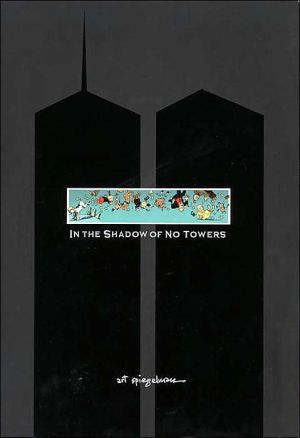In the Shadow of No Towers
For Art Spiegelman, the Pulitzer Prize-winning author of Maus, the terrorist attacks of September 11, 2001 were both highly personal and intensely political. In the Shadow of No Towers, his first new book of comics since the groundbreaking Maus, is a masterful and moving account of the events and aftermath of that tragic day.\ Spiegelman and his family bore witness to the attacks in their lower Manhattan neighborhood: his teenage daughter had started school directly below the towers days...
Search in google:
For Art Spiegelman, the Pulitzer Prize-winning author of Maus, the terrorist attacks of September 11, 2001 were both highly personal and intensely political. In the Shadow of No Towers, his first new book of comics since the groundbreaking Maus, is a masterful and moving account of the events and aftermath of that tragic day. Spiegelman and his family bore witness to the attacks in their lower Manhattan neighborhood: his teenage daughter had started school directly below the towers days earlier, and they had lived in the area for years. But the horrors they survived that morning were only the beginning for Spiegelman, as his anguish was quickly displaced by fury at the U.S. government, which shamelessly co-opted the events for its own preconceived agenda. He responded in the way he knows best. In an oversized, two-page-spread format that echoes the scale of the earliest newspaper comics (which Spiegelman says brought him solace after the attacks), he relates his experience of the national tragedy in drawings and text that convey—with his singular artistry and his characteristic provocation, outrage, and wit—the unfathomable enormity of the event itself, the obvious and insidious effects it had on his life, and the extraordinary, often hidden changes that have been enacted in the name of post-9/11 national security and that have begun to undermine the very foundation of American democracy.The New York Times Sunday Book Review - David HajduIn the Shadow of No Towers looks like a repudiation of the undergrounds and their progeny, a rejection of their now generic graphic crudity in favor of an approach that is simultaneously contemporary and antique. Spiegelman employs an unexpected variety of drawing styles and graphic techniques -- his familiar scrawls; painterly images in soft, pastelish shades; computer scans, sometimes digitized for interpretive effect; and appropriations of long-forgotten newspaper comic-strip characters. Five or six story segments or graphic elements in different styles -- one running vertically, one in a large circle, one broken up into images laid out like snapshots on the floor -- all play off one another in an effect that suggests the scattershot multiformity of the Web.
In the Shadow of No Towers\ \ By Art Spiegelman \ Pantheon\ Copyright © 2004 Art Spiegelman\ All right reserved.\ ISBN: 0-375-42307-9 \ \ \ Introduction\ The Sky Is Falling! \ I tend to be easily unhinged. Minor mishaps-a clogged drain, running late for an appointment-send me into a sky-is-falling tizzy. It's a trait that can leave one ill-equipped for coping with the sky when it actually falls. Before 9/11 my traumas were all more or less self-inflicted, but outrunning the toxic cloud that had moments before been the north tower of the World Trade Center left me reeling on that faultline where World History and Personal History collide-the intersection my parents, Auschwitz survivors, had warned me about when they taught me to always keep my bags packed.\ It took a long time to put the burning towers behind me. Personal history aside, zip codes seemed to have something to do with the intensity of response. Long after uptown New Yorkers resumed their daily jogging in Central Park, those of us living in Lower Manhattan found our neighborhood transformed into one of those suburban gated communities as we flashed IDs at the police barriers on 14th Street before being allowed to walk home. Only when I traveled to a university in the Midwest in early October 2001 did I realize that all New Yorkers were out of their minds compared to those for whom the attack was an abstraction. The assault on the Pentagon confirmed that the carnage in New York City was indeed an attack on America, not one more skirmish on foreign soil. Still, the small town I visited in Indiana-draped in flags that reminded me of the garlic one might put on a door to ward off vampires-was at least as worked up over a frat house's zoning violations as with threats from "raghead terrorists." It was as if I'd wandered into an inverted version of Saul Steinberg's famous map of America seen from Ninth Avenue, where the known world ends at the Hudson; in Indiana everything east of the Alleghenies was very, very far away.\ One of my near-death realizations as the dust first settled on Canal Street was the depth of my affection for the chaotic neighborhood that I can honestly call home. Allegiance to this unmelted nugget in the melting pot is as close as I comfortably get to patriotism. I wasn't able to imagine myself leaving my city for safety in, say, the south of France, then opening my Herald Tribune at some café to read that New York City had been turned into radioactive rubble. The realization that I'm actually a "rooted" cosmopolitan is referred to in the fourth of the No Towers comix pages that follow, but the unstated epiphany that underlies all the pages is only implied: I made a vow that morning to return to making comix full-time despite the fact that comix can be so damn labor intensive that one has to assume that one will live forever to make them.\ In those first few days after 9/11 I got lost constructing conspiracy theories about my government's complicity in what had happened that would have done a Frenchman proud. (My susceptibility for conspiracy goes back a long ways but had reached its previous peak after the 2000 elections.) Only when I heard paranoid Arab Americans blaming it all on the Jews did I reel myself back in, deciding it wasn't essential to know precisely how much my "leaders" knew about the hijackings in advance-it was sufficient that they immediately instrumentalized the attack for their own agenda. While I was going off the deep end in my studio, my wife, Françoise, was out impersonating Joan of Arc-finding temporary shelter for Tribeca friends who'd been rendered homeless, sneaking into the cordoned-off areas to bring water to rescue workers and even, as art editor of The New Yorker, managing to wrest a cover image from me, a black-on-black afterimage of the towers published six days after the attack.\ I'd spent much of the decade before the millennium trying to avoid making comix, but from some time in 2002 till September 2003 I devoted myself to what became a series of ten large-scale pages about September 11 and its aftermath. It was originally going to be a weekly series, but many of the pages took me at least five weeks to complete, so I missed even my monthly deadlines. (How did the newspaper cartoonists of the early twentieth century manage it? Was there amphetamine in Hearst's water coolers?) I'd gotten used to channeling my modest skills into writing essays and drawing covers for The New Yorker. Like some farmer being paid to not grow wheat, I reaped the greater rewards that came from letting my aptitude for combining the two disciplines lie fallow.\ A restlessness with The New Yorker that predated 9/11 grew as the magazine settled back down long before I could. I wanted to make comix-after all, disaster is my muse!-but the magazine's complacent tone didn't seem conducive to communicating hysterical fear and panic. At the beginning of 2002, while I was still taking notes toward a strip, I got a fortuitous offer to do a series of pages on any topic I liked from my friend Michael Naumann, who had recently become the editor and publisher of Germany's weekly broadsheet newspaper, Die Zeit. It allowed me to retain my rights in other languages and came complete with a promise of no editorial interference-an offer no cartoonist in his right mind could refuse. Even one in his wrong mind.\ The giant scale of the color newsprint pages seemed perfect for oversized skyscrapers and outsized events, and the idea of working in single page units corresponded to my existential conviction that I might not live long enough to see them published. I wanted to sort out the fragments of what I'd experienced from the media images that threatened to engulf what I actually saw, and the collagelike nature of a newspaper page encouraged my impulse to juxtapose my fragmentary thoughts in different styles.\ -Art Spiegelman, NYC, February 16, 2004\ (Continues...)\ \ \ \ \ Excerpted from In the Shadow of No Towers by Art Spiegelman Copyright © 2004 by Art Spiegelman. Excerpted by permission.\ All rights reserved. No part of this excerpt may be reproduced or reprinted without permission in writing from the publisher.\ Excerpts are provided by Dial-A-Book Inc. solely for the personal use of visitors to this web site. \ \
\ From Barnes & NobleIn 1992, Maus, Art Spiegelman's graphic novel about a mouse's experience in Nazi-occupied Europe, captured the world's imagination. By presenting the Holocaust through the eyes of a lowly viewer, Spiegelman's Pulitzer Prize-winning work infused historical events with human immediacy. Now, in his first new book of comics since Maus, this longtime New York City resident gives a deeply personal, politically charged account of the tragic events and ghastly aftermath of September 11, 2001. "I hadn't anticipated," he writes in the introduction, "that the hijackings of September 11th would themselves be hijacked by the Bush cabal that reduced it all to a war recruitment poster."\ \ \ \ \ Christopher TheokasNo Towers is provocative and partisan. But it's also very personal. Spiegelman offers his fears, his horror and his anger for everyone to see.\ — USA Today\ \ \ David HajduIn the Shadow of No Towers looks like a repudiation of the undergrounds and their progeny, a rejection of their now generic graphic crudity in favor of an approach that is simultaneously contemporary and antique. Spiegelman employs an unexpected variety of drawing styles and graphic techniques -- his familiar scrawls; painterly images in soft, pastelish shades; computer scans, sometimes digitized for interpretive effect; and appropriations of long-forgotten newspaper comic-strip characters. Five or six story segments or graphic elements in different styles -- one running vertically, one in a large circle, one broken up into images laid out like snapshots on the floor -- all play off one another in an effect that suggests the scattershot multiformity of the Web.\ — The New York Times Sunday Book Review\ \ \ \ \ Michiko KakutaniIt is a testament to Art Spiegelman's uncompromising vision that In the Shadow of No Towers - his account of 9/11 and its aftermath - makes no effort to contain or domesticate the surreal awfulness of that day.\ — The New York Times\ \ \ \ \ Publishers WeeklyPulitzer Prize-winning cartoonist Spiegelman's new work is an inventive and vividly graphic work of nonfiction. It's an artful rant focused on the events of 9/11 and afterward by a world-class pessimist ("after all, disaster is my muse"). The artist, who lives in downtown Manhattan, believes the world really ended on Sept. 11, 2001 it's merely a technicality that some people continue to go about their daily lives. He provides a hair-raising and wry account of his family's frantic efforts to locate one another on September 11 as well as a morbidly funny survey of his trademark sense of existential doom. "I'm not even sure I'll live long enough," says a chain-smoking, post-9/11 cartoon-mouse Spiegelman, "for cigarettes to kill me." The book is a visceral tirade against the Bush administration ("brigands suffering from war fever") and, when least expected, an erudite meditation on the history of the American newspaper comic strip, born during the fierce circulation wars of the 1890s right near the World Trade Center site in lower Manhattan. This beautifully designed, oversized book (each page is heavy board stock) opens vertically to offer large, colorful pages with Spiegelman's contemporary lamentations along with wonderful reproductions of 19th-century broadsheet comic strips like Richard Outcault's Hogan's Alley and Rudolf Dirk's Katzenjammer Kids. Old comics, Spiegelman (Maus) writes, saved his sanity. "Unpretentious ephemera from the optimistic dawn of the 20th century... they were just right for an end-of-the world moment." This is a powerful and quirky work of visual storytelling by a master comics artist. (Sept.) Copyright 2004 Reed Business Information.\ \ \ \ \ VOYAIn a manner that is both accessible and cogent, Pulitzer Prize-winning cartoonist Spiegelman presents his very personal observation of and response to the obliteration of the World Trade Center. Living as he does in lower Manhattan and having children who went to school on the morning of September 11, his experiences of the day's events are relatively at ground zero. By distilling what he saw, felt, thought, and did both in the immediacy of the event and in the weeks following as the event became a political football, he gives readers the opportunity to meet both the physical situation and the cultural ramifications in a kind of aesthetic nakedness that is clarifying and revealing. The physicality of this book is itself studied: A folio printed entirely on board, its narrative is told in full-page spreads that borrow from old comics pages as well as include reportorial panels depicting the WTC's evaporation. The narrative portrays Spiegelman's role as parent, his teenaged daughter's response to the patriotic fervor at her newly assigned school, and his wife's efforts to get a New Yorker cover wrested from him in her role as that magazine's art editor. Despite the text's brevity and the enormity of each spread, it is easy to read this book repeatedly and find new story strands, new realizations of what the event continues to mean, and how history changes even while it is being lived. Processing and shelving this book in libraries should be done respectfully; it is sure to be a lasting icon in American studies. VOYA CODES: 4Q 4P J S A/YA G (Better than most, marred only by occasional lapses; Broad general YA appeal; Junior High, defined as grades 7 to 9; Senior High, defined as grades 10to 12; Adult-marketed book recommended for Young Adults; Graphic Novel Format). 2004, Pantheon, 42p., Ages 12 to Adult. \ —Francisca Goldsmith\ \ \ \ \ Library JournalIn his first new graphic novel since Maus, Spiegelman uses his unique artistry to capture the tragedy of 9/11 and what he considers its shameful misappropriation by the U.S. government. Copyright 2004 Reed Business Information.\ \








